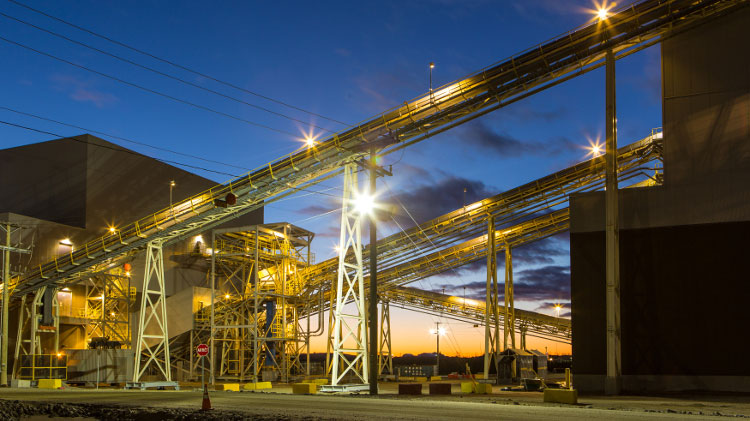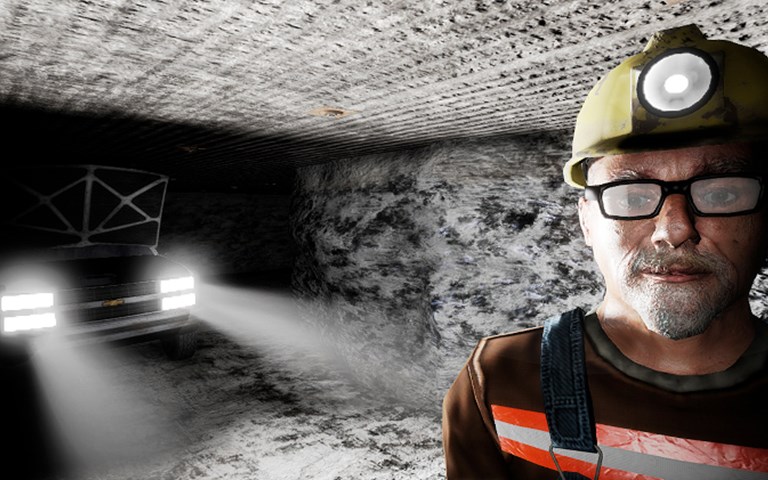A screenshot from Harry's Hard Choices. Courtesy of Desert Saber
Imagine the scenario: A crew in an underground coal mine is trying to escape a fire that is slowly spreading. As they make their way out in an underground vehicle, it breaks down. The crew debates whether to fix the broken-down pickup truck or continue on foot. Time is precious; the mine is slowly filling up with smoke. Once the crew opts to walk, an ankle injury causes a team member to collapse. Another discussion ensues as to what to do: leave the injured miner, help him hobble out of the mine, or turn back to the refuge chamber? Each decision could mean life or death for the miners.
This is just one chain of scenarios built into Tucson-based startup Desert Saber’s new video game, Harry’s Hard Choices. The company hopes its game technology will revolutionize and improve mine health and safety training. Their game is now being used by accredited mining health and safety trainers across the United States.
Harry’s Hard Choices was initially a paper-and-pencil exercise produced by the United States National Institute for Occupational Safety and Health (NIOSH) for mine refuge chamber training. Those completing the exercise had to simulate being Harry, an unlucky coal miner who discovers a fire in his mine. Guided by a mine health and safety trainer, students had to make a series of decisions that would save the fictional Harry and his crew from a grisly underground death.
Thanks to Desert Saber, miners can now live Harry’s ordeal with more realism and detail. Leonard Brown, Desert Saber founder and CEO, said the game resolves “a number of critical issues” his team identified in previous classroom approaches.
Brown’s computer science dissertation at the University of Arizona (UA) looked at how “serious games” – video games designed for a purpose other than pure entertainment – could be used to benefit miners. His PhD grew into a broader research project at UA when he teamed up with Michael Peltier, lead programmer at the university’s Lowell Institute for Mineral Resources, and Mary Poulton, the institute’s director. Poulton is now COO at Desert Saber, which was founded to license the technology from UA for commercialization, and Peltier is director of engineering.
Safety training doesn’t have to be dull
Inexperienced surface miners in the U.S. are required to take a 24-hour training course and underground miners must complete 40 hours of training. All miners have to take an annual eight-hour refresher course. Training is done in-house at larger mining companies, or run by third-party training companies. Traditionally, sessions tend to be “PowerPoint-based and content driven,” Poulton explained. “[Trainees] are really at the end of a firehose, with content shooting at them. There’s no real measure of what they are comprehending, what they are doing with the material, or how they are progressing over the time. There’s no real critical thinking.”
That approach is “based on seat times,” according to Brown. “There’s a lack of context, there’s a lack of ability to show consequences […] There’s a lack of engagement with the end user.”
The game immerses miners into an interactive environment where they can see and experience the direct results of their mistakes or actions. There are countless “traps” laced throughout the game, like a defective gas meter or uneven ground, which can lead to asphyxiation, being crushed by a collapsed roof, electrocution, disorientation, leg injury, burns, abandonment and death. Many of the scenarios are inspired by the original Harry’s Hard Choices paper exercise, although there are also new hazards and alternate story lines.
Related: Vic Pakalnis of MIRARCO says the road to risk mitigation is long, but worth the haul
Players have to identify the traps and communicate efficiently with their mine crew – who inevitably chime in with different solutions – to come up with a plan of action. “We emphasize leadership and communication skills,” explained Peltier. “When you make bad choices the entire crew’s morale goes down. It can get to the point where they are disruptive, or even abandon you.”
The game is unpredictable and the storyline nonlinear, with players facing different situations and scenarios in a jumbled order each time. The overall premise remains the same: trainees must use their disaster response knowledge to evacuate the crew to safety before the fire spreads.
Miners, NIOSH engineers and researchers, emergency response training experts, and disaster drill and simulation experts pitched in to keep the game as close to reality as possible. Health and safety experts advised on characters’ health metrics, and behavioural psychologists were consulted on how best to convey different personality types and differing stress levels.
Make it fun and they will come
A recent showcase of the game at a U.S. mine rescue competition confirmed its appeal. According to Desert Saber, several players asked if they could have the game afterwards for entertainment purposes. “It’s not often that you get training material that people want to take home and use for fun,” Peltier said.
Poulton added that the game appeals to miners’ inherently “competitive nature.” At the same competition, mining crews jostled to replay, wanting to climb the leader boards and trounce rival teams. The game can be played in either single- or multi-player mode.
Glenna Davenport-Smith is a mine safety trainer at McCraren Compliance, one of the first third-party training companies to get on board with Desert Saber. She described Harry’s Hard Choices as “the most exciting training tool” she has seen in decades, in particular because it suits the largely millennial incoming workforce. “This is the kind of world they now live in.” She said she has seen significantly higher levels of participation in classes since she started using the tool.
On the programming side, a key challenge was that the game needed a “number of pieces of infrastructure that simply didn’t exist for video games,” said Peltier. These included adding elements that would control the environment, such as the rate of the spread of the fire or gas. All the physics in the game are accurate; Desert Saber collaborated with NIOSH to run airflow pattern simulations on a supercomputer and then input them into the game.
Related: Roy Slack of Cementation says frontline supervisors play a key role in establishing safety culture
Harry’s Hard Choices can be played on devices ranging from a small Android device to PCs, game consoles and virtual reality (VR) headsets. This was a calculated move to make the technology accessible to all types of mine training operations. Trainers working in a small sand-and-gravel operation with a handful of employees can invest in a smaller platform, while the system can be scaled up for trainers with more resources. “We wanted to open it up to everyone,” Peltier said.
Taking it to the next level
Desert Saber has international ambitions and three prospective mine clients with significant operations in Canada, all mid to large multinationals that run the gamut of metals, non-metals and construction aggregates. Given that the regulatory environment in Canada is different, Brown said the games can take on a “different flavour” for Canadian companies, although the tenets of mining health and safety are the same.
After the successful commercialization of Harry’s Hard Choices, the team is now building on the existing technology to develop a second game, Harry’s Hazardous Day. It focuses on jobsite inspections, hazard recognition and situational awareness. It will also be a more customized experience; trainers will have the option of using their worksite as the game environment, or prioritizing storylines that address a particular safety issue at their operation. Desert Saber is already working with several industry partners on customizations and is hopeful that the game will be complete in early 2018.
The team is also working on augmented reality (AR) and mixed reality (MR) for future games, building on current VR display capabilities. In VR and MR, gamers’ hand and body motions would interact with virtual equipment and their motions and body posture would be tracked through sensors. Thus, users would be penalized for postures and physical actions that would result in real-world injuries, like lifting a piece of equipment incorrectly. “Strains, sprains, slips and falls are among the most common classes of injuries in the mining industry, accounting for huge losses in productivity each year,” Brown explained.
In AR, MR and VR, health effects would be displayed through sensory feedback. For example, if a user forgets to wear protective eye gear and debris blinds them in the game, half of their screen would be permanently blacked out or obscured. Tinnitus could be re-enacted as a persistent ringing that the user hears following noise exposure.
Desert Saber is also looking into the option of streaming real data into the game from a mine site. “Every client has different needs,” Brown explained, “so we try to accommodate them in part by supporting a variety of different technologies and use cases.”



